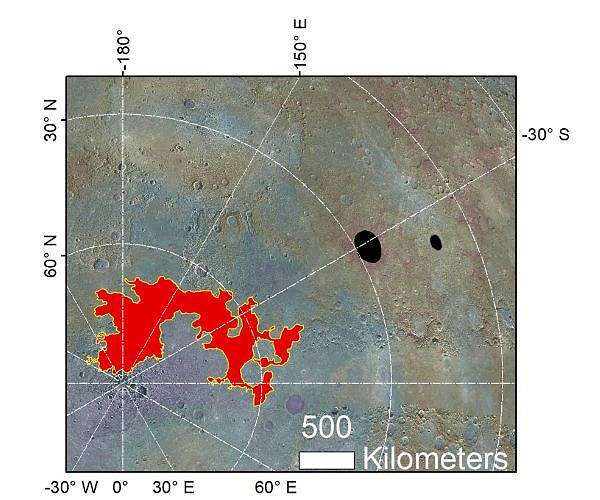20.11.2023

A view of Mercury's north polar chaotic terrain (Borealis Chaos) and the Raditladi and Eminescu craters where evidence of possible glaciers has been identified. Credit: NASA.
Scientists from the Planetary Science Institute have uncovered evidence of potential salt glaciers on Mercury, opening a new frontier in astrobiology by revealing a volatile environment that might echo habitability conditions found in Earth's extreme locales.
"Our finding complements other recent research showing that Pluto has nitrogen glaciers, implying that the glaciation phenomenon extends from the hottest to the coldest confines within our Solar System. These locations are of pivotal importance because they identify volatile-rich exposures throughout the vastness of multiple planetary landscapes," said Alexis Rodriguez, lead author of the paper "Mercury's Hidden Past: Revealing a Volatile-Dominated Layer through Glacier-like Features and Chaotic Terrains" that appears in the Planetary Science Journal. PSI scientists Deborah Domingue, Bryan Travis, Jeffrey S. Kargel, Oleg Abramov, John Weirich, Nicholas Castle and Frank Chuang are co-authors of the paper.
"These Mercurian glaciers, distinct from Earth's, originate from deeply buried Volatile Rich Layers (VRLs) exposed by asteroid impacts. Our models strongly affirm that salt flow likely produced these glaciers and that after their emplacement they retained volatiles for over 1 billion years," said co-author Travis.
"Specific salt compounds on Earth create habitable niches even in some of the harshest environments where they occur, such as the arid Atacama Desert in Chile. This line of thinking leads us to ponder the possibility of subsurface areas on Mercury that might be more hospitable than its harsh surface. T
hese areas could potentially act as depth-dependent 'Goldilocks zones,' analogous to the region around a star where the existence of liquid water on a planet might enable life as we know it, but in this case, the focus is on the right depth below the planet's surface rather than the right distance from a star," Rodriguez said. "This groundbreaking discovery of Mercurian glaciers extends our comprehension of the environmental parameters that could sustain life, adding a vital dimension to our exploration of astrobiology also relevant to the potential habitability of Mercury-like exoplanets."
The discovery challenges the long-held view of Mercury as primarily devoid of volatiles and fortifies the understanding of VRLs, potentially hidden deep beneath the planet's surface.
"The glaciers on Mercury are marked by a complex configuration of hollows that form widespread (and very young) sublimation pits. These hollows exhibit depths that account for a significant portion of the overall glacier thickness, indicating their bulk retention of a volatile-rich composition. These hollows are conspicuously absent from surrounding crater floors and walls. "
This observation provides a coherent solution to a previously unexplained phenomenon: the correlation between hollows and crater interiors. The proposed solution hypothesizes that clusters of hollows within impact craters may originate from zones of VRL exposures induced by impacts, thereby elucidating a connection that has long baffled planetary scientists," said co-author Domingue.
"A central mystery concerning Mercury revolves around the genesis of its glaciers and chaotic terrains. What mechanism was responsible for the formation of VRLs? In our research, we introduce a model that integrates recent observational data to address this question. Notably, we examine the Borealis Chaos, located in Mercury's north polar region.
"This area is characterized by intricate patterns of disintegration, significant enough to have obliterated entire populations of craters, some dating back approximately 4 billion years. Beneath this collapsed layer lies an even more ancient, cratered paleo-surface, previously identified through gravity studies.
The juxtaposition of the fragmented upper crust, now forming chaotic terrain, over this gravity-revealed ancient surface, suggests that the VRLs were emplaced atop an already solidified landscape," Rodriguez said.
"These findings challenge prevailing theories of VRL formation that traditionally centered on mantle differentiation processes, where minerals separate into different layers within the planet's interior. Instead, the evidence suggests a grand-scale structure, possibly stemming from the collapse of a fleeting, hot primordial atmosphere early in Mercury's history. This atmospheric collapse might have occurred mostly during the extended nighttime periods when the planet's surface was not exposed to the Sun's intense heat."
"Underwater deposition could have significantly contributed to the emplacement of a salt-dominated Mercurian VRL, marking a significant departure from previous theories about the planet's early geological history. In this scenario, water released through volcanic degassing may have temporarily created pools or shallow seas of liquid or supercritical water (like a dense, highly salty steam), allowing salt deposits to settle. Subsequent rapid loss of water into space and trapping of water in hydrated minerals in the crust would have left behind a salt- and clay mineral-dominated layer, which progressively built up into thick deposits," co-author Kargel said.
Quelle: SD
